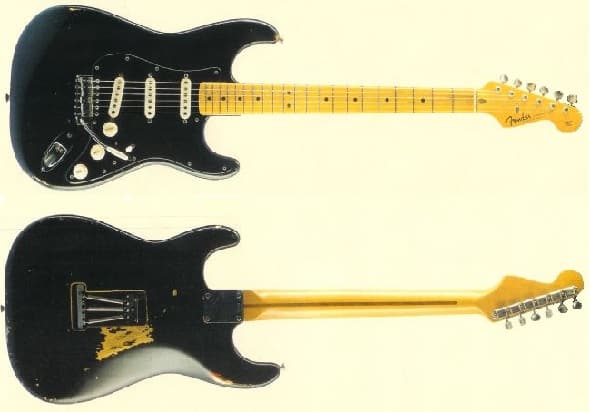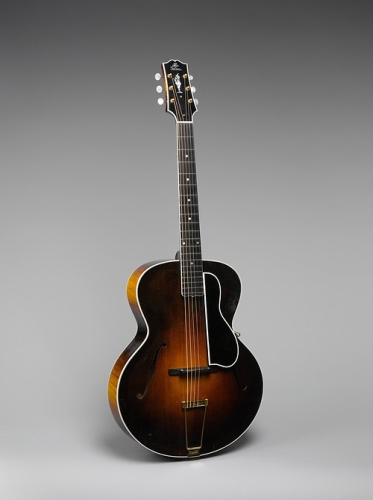The Telecaster in the 1950s

Early 1950s Fender ad for the then-new Telecaster. |
Uncluttered and straightforward it may have been, but those are the attributes that remain at the heart of the Telecaster’s appeal.
-Tony Bacon,
Six Decades of the Fender Telecaster
While Leo Fender and the staff of his small Southern California instrument- and amp-making company knew that they’d built a revolutionary new guitar when they introduced the Telecaster in early 1951, they had no idea of the size and scope of the musical revolution their unusual new invention would start. They couldn’t possibly have.
It was not a foregone conclusion that such an instrument would succeed; indeed, some scoffed and laughed at the Telecaster when it was officially unveiled that year at the industry's largest U.S. trade show, mocking it as a “boat paddle” and a “snow shovel.” This kind of derision didn’t last long, though.
That’s because players quickly realized that Fender had given them something not only new and unusual, but something well-designed, easy-playing, efficient, rugged, affordable and, above all, great-sounding. Although electri
fied guitars had been around in various forms since the 1920s, Leo Fender and his inner circle had labored mightily throughout the close of the 1940s and the earliest dawn of the new decade to design and perfect something that really didn’t exist before—a mass-produced solid-body Spanish-style electric guitar.

European Staufer guitar, circa 1830s. Note the headstock, with all tuners on one side and straight string pull over the nut. Leo Fender adopted these design elements for the Telecaster. |
As innovative as it was, little if anything was fancy about the Telecaster. Several of its features were carried over from the Hawaiian steel guitars Fender had already been making since 1945, such as the “ashtray” bridge cover, knurled chrome knobs, Kluson tuners and combination of bridge and bridge pickup in one integral unit. If the maple neck broke or became too worn, there was no complex luthiery involved—you just screwed on a new one. It had a simple black pickguard (of fiber or Bakelite) held on with five screws. Unlike many existing guitars at the time, the Telecaster’s strings were pulled straight over the nut, with all the tuners on one side of the headstock—ideas that Leo himself said he borrowed from 19-century Istrian folk guitars and Viennese Staufer guitars.
The controls were another matter. True, the layout was simple—two knobs and a three-position switch, but their combined function was not as simple as might be supposed at first. The front knob always controlled master volume, but the rear knob was
not always a master tone knob. In 1951, putting the selector switch in the rear (bridge) position delivered both pickups, with the rear knob serving as a blend control that governed the amount of neck pickup sound mixed into the bridge pickup sound. The selector switch in the middle position delivered the neck pickup only with its “natural” mellow tone (its chrome cover soaked up extra capacitance), and the switch in the front (neck) position delivered the neck pickup only with extra capacitance that produced a bassier tone; the rear knob affected neither of these settings.
This control arrangement was “simplified” in 1952 to what became known as the conventional Telecaster control layout. After this change, putting the selector switch in the rear (bridge) position delivered the bridge pickup alone, with the rear knob acting as a proper tone control. The selector switch in the middle position delivered the neck pickup alone, with the rear knob again acting as a tone control. The selector switch in the front (neck) position delivered the neck pickup alone with the preset bassier sound and a non-functioning rear knob (as before). In this control scheme, there was no switch setting in which both pickups were on at the same time, an arrangement that lasted until the late 1960s. However, players were quick to discover that the Telecaster’s three-position switch could be precariously balanced in the two “in-between” switch positions to deliver in-phase or out-of-phase sounds (depending on the polarity of the pickups) in which both pickups were on (an unintentional design feature exploited by players to even greater extent on the Stratocaster).
So there was quite a bit of tonal versatility there. Unlike any guitar that came before it, the Telecaster had an incredibly bright, clean and cutting sounding, with a piercing high end and thick midrange and bass. It made a distinctive and irresistible sound, and through the sturdy amps that Fender had been making since the mid-1940s, it was
loud.

Two monumental early Telecaster albums; 2 Guitars Country Style by Speedy West and Jimmy Bryant (1954) and Johnny Burnette and the Rock ‘n Roll Trio (1956).
 |
Outside the factory, the western swing guitarists who helped Leo perfect his new guitar were the first to fully understand how good the Telecaster really was. Early players such as Jimmy Wyble, Charlie Aldrich, Jimmy Bryant, Roy Watkins and Bill Carson took to the instrument with missionary zeal, and Fender Sales chief Don Randall’s carefully built sales network made sure the appeal of the Telecaster slowly but surely radiated from Southern California all the way to the East Coast.
With the introduction of the even more revolutionary Precision Bass less than a year after the February 1951 debut of the Telecaster, Fender had unknowingly helped set the stage for a musical explosion—rock ‘n’ roll. It bears remembering that when the Telecaster was introduced in 1951, rock ‘n’ roll was still a few years away; Leo Fender and his staff were building guitars and amps mainly for the western swing guitarists whose touring circuits often brought them near the company’s home in sunny Southern California. Nonetheless, Fender’s innovative new instruments fed the rise of the small, loud bands that, by the mid-1950s, had largely supplanted the big bands of the 1930s and 1940s, a phenomenon that in turn fueled the concurrent explosion of U.S. youth culture.
Fender and its new Telecaster guitar were ideally placed to take advantage of all of this, because Fender didn’t belong to the stodgy old world of high-end guitar craft. Fender was brash, young, innovative and West Coast; not old, staid and East Coast. Fender instruments and amps were fun, tough and affordable rather than delicate and expensive. All those kids who found themselves with a powerful new cultural movement of their own in the post-war mid-1950s could get their hands on great-sounding, solidly built Fender guitars easily enough.
Consequently, by mid-decade the Telecaster was finding its way into the inventive hands of rock ‘n’ roll, R&B and country guitarists and onto their recordings. In Nashville in July 1956, Johnny Burnette and the Rock and Roll Trio recorded an energetic rock ‘n’ roll version of 1951 jump blues song “The Train Kept-A-Rollin”; lead guitarist Paul Burlison used his Telecaster to play one of the first recorded instances—if not
the first recorded instance—of a contemporary fuzz guitar sound. In July 1957, Dale Hawkins scored what was probably the first Telecaster-fueled U.S. Top 40 hit with “Suzie Q,” a song built on a catchy guitar lick by his band’s young guitarist, James Burton.

Telecaster master-in-the-making James Burton plays “It’s Late” with Ricky Nelson on the April 8, 1959, episode of ABC TV’s The Adventures of Ozzie and Harriet. |
When Burton later joined teen idol Ricky Nelson’s band (at age 18), thousands of U.S. TV viewers saw Burton play his Telecaster on
The Adventures of Ozzie and Harriet in the late ’50s and early ’60s, playing songs such as “Hello Mary Lou,” “Just a Little Too Much,” “It’s Late” “Believe What You Say” and many more.
And in what is widely regarded as the greatest rock ‘n’ roll film ever made, 1956’s
The Girl Can’t Help It, the Telecaster (in its single-pickup Esquire version) puts in a pair of appearances. It’s first seen in the hands of Little Richard’s guitarist (likely either Ray Montrell or Ed Blanchard) during the hard rocking “Ready Teddy” and “She’s Got It”; guitarist Russell Willaford plays one later in the film during Gene Vincent and His Blue Caps’ smoldering “Be Bop a Lula.”
In the R&B world, players such as B.B. King and Clarence “Gatemouth” Brown took readily to the Telecaster. And when the great Muddy Waters, the man who electrified Delta blues, first visited England in 1958, he shocked audiences who were expecting folksy acoustic sounds by blasting out loud, stinging blues on his Telecaster. For many young players in the U.K., Waters’ October 1958 tour was the first time they ever saw a Telecaster in real life. The dramatic effects of this would become palpably evident in the decade that followed.

Gene Vincent and His Blue Caps guitarist Russell Willaford brandishes a Fender Esquire on this lobby card for 1956 film The Girl Can’t Help It. |
In the country world, Luther Perkins accompanied Johnny Cash from 1954 on by playing bright, catchy lines on a Telecaster and an Esquire. Farther west, in Bakersfield, Calif., a soon-to-be rising star named Buck Owens was discovering how to put the Telecaster to work in a loud and stripped-down country style that stood in stark contrast to the slick, string-heavy country sound then in vogue in Nashville. The Telecaster would become the foundation of the “Bakersfield Sound” pioneered in the later 1950s and popularized in the 1960s by Owens and his band, the Buckaroos, Merle Haggard and the Strangers, and others.
The Telecaster also made great inroads in the 1950s as a must-have studio session instrument. It didn’t take long to become an essential element in the arsenal of studio veterans nationwide because it quickly became an in-demand sound. A-list session veterans Barney Kessel, Howard Roberts and Tommy Tedesco all got Telecasters, like it or not (in
Six Decades of the Fender Telecaster, author Tony Bacon recounts a 1956 interview in which jazzer Kessel, “the busiest session guitar man in Hollywood,” snorted about the Telecaster that “I had to buy a special ‘ultra toppy’ guitar to get that horrible electric guitar sound that the cowboys and the rock ‘n’ rollers want”).
Through all of this and through the entire decade, the Telecaster remained remarkably unchanged (even today, 60 years after its invention, a basic modern Telecaster outwardly differs very little from its ancestors of 1951). Its simplicity and efficiency as a solidly reliable workhorse guitar remained hallmarks of its design throughout the 1950s, as indeed they would throughout subsequent decades.
A few minor changes to the Telecaster
were implemented in the guitar’s first decade. The color of the pickguard was changed from black to white in 1954; its pickup selector switch tip was changed from the original round type to the “top hat” type in 1955. Perhaps the biggest change of the decade came in 1958, when the once blonde-finish-only Telecaster first became available with eye-catching custom color finishes for an additional 5 percent cost. The first significant new version of the model didn’t appear until 1959, when the Custom Telecaster was introduced, with a bound body and rosewood fingerboard.

Pre-1954 “blackguard” (black pickguard) Telecasters are now highly valued among collectors, as chronicled in 2005 book The Blackguard. |
All in all, the Telecaster was a great success story in the decade of its birth. The 1950s saw it rise from regional obscurity to nationwide indispensability (with worldwide acclaim looming) as rock ‘n’ roll proved to be more than a passing fad and youth culture bloomed as it never before had in the United States. The Telecaster had both the style and substance; the form and function to endure indefinitely as both a valuable tool and a potent symbol. It was a great idea whose time had come, and it changed music in the ’50s-era United States.
And half a world away across the great Atlantic, on the shores from which the Colonies had long since asserted their independence, a talented and hungry new generation of upcoming guitarists regarded the Telecaster and Fender’s other wares with envious eyes and ears. Up and down the length of Great Britain, they devoured every record Burton played on, sat enthralled by Waters’ roaring electric blues and studiously dissected every Cliff Gallup lick until they’d mastered them completely.
In late 1959, with the decade rapidly closing, quite a few of these English kids were eagerly soaking up every Telecaster-fueled note they could get their hands on. These included 16-year-olds Keith Richards and George Harrison, 15-year-olds Jeff Beck and James Page, 14-year-olds Eric Clapton and Peter Townshend, 13-year-old schoolmates Roger “Syd” Barrett and David Gilmour, 17-year-old Andy Summers and a great many more. They all immersed themselves in the sounds of the Telecaster in the 1950s, and they all eventually got their hands on Telecaster guitars.
Which boded extremely well for the wild and adventurous decade to follow …
 When blues great Muddy Waters took his Telecaster to England in 1958, a lot of British kids were paying attention.
COPYRIGHT BY FENDER'S WEB SITE
When blues great Muddy Waters took his Telecaster to England in 1958, a lot of British kids were paying attention.
COPYRIGHT BY FENDER'S WEB SITE
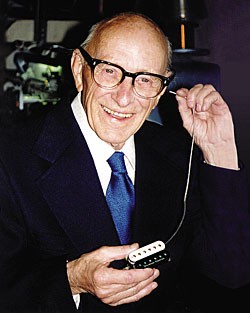

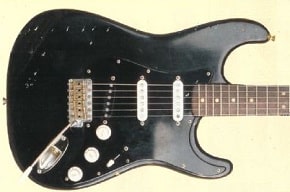
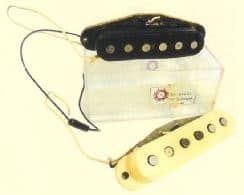
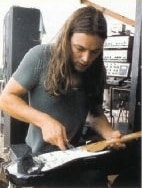 David Gilmour working on the Black Strat
David Gilmour working on the Black Strat